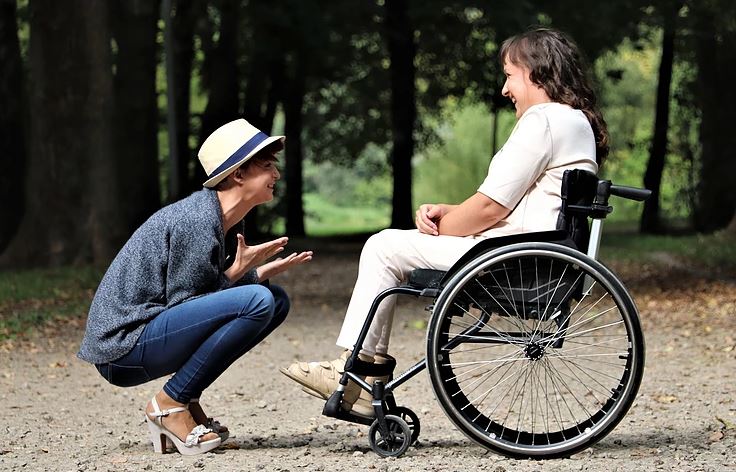ALS, or Amyotrophic Lateral Sclerosis, typically affects people aged 40 to 70, with an estimated population of approximately 20,000 Americans with the diagnosis. Although there is no known cure for the disease, there has been significant advances in the science behind understanding the physiology of the disease. Before we discuss the options available, we must first consider the prognosis as there are treatments to consider based on the stage at which the disease has progressed.
Prognosis
The typical life span of someone with ALS is 2-5 years after experiencing their first signs of the disease, however at least 1 in 10 people live more than 10 years following their diagnosis. This variation can make predicting prognosis challenging. Therefore, it is important that persons with ALS attend regular clinic visits every 3-4 months to monitor the disease progression and changes in their functional abilities.
Early Stages
The first symptom people typically experience with ALS is muscle twitching, muscle cramps and/or muscle spasms in one of their arms or legs. Other signs include weakness in the hands or feet, or loss of balance. When this type of loss occurs, it is considered limb-onset ALS. Conversely, there are 25% of people with ALS whose initial sign is difficulty speaking or slurring of their words. This type of loss is indicative of bulbar-onset ALS. In this early stage, it may be useful to start use of a spirometer, which helps to measure lung function based on the maximum amount of air that can be inhaled and exhaled.
Middle Stages
As the disease progresses and the symptoms spread, many people experience weakened and stiff muscles. In order to prevent contractures, daily exercise and range of motion exercises are recommended to keep muscles loose and keep pain at bay. In the middle stages, many become tired more easily and their breathing can be affected.
At this middle stage, it may be necessary to begin using a bi-level positive airway pressure (BiPAP) or continuous positive airway pressure (CPAP) machine to help with breathing, particularly while sleeping. Those with bulbar-onset will need the help of a speech therapist to keep their communication optimal, as good respiratory support is required to keep voice clear and audible. In addition to altering speech, the disease process can place those with ALS at higher risk for developing pneumonia from getting food, liquid or saliva into the lungs as a result of weakened swallow muscles. The services of a speech therapist can also help with maintaining safe oral intake for as long as possible. If the oral musculature is severely affected, then a feeding tube may be considered in order to help with nutrition.
For those persons with limb-onset ALS, they will require the services of an occupational therapist to recommend adaptive equipment and training strategies to help with completing day-to-day activities and maintaining maximum independence while training caregivers how to properly care for the person with ALS as the disease progresses. People in the middle stages may have difficulty with balance or walking and start to rely on a cane, walker or wheelchair for mobility, which can also be addressed by the occupational therapist.
Late Stages
With further disease progression into the late stages, the muscles become paralyzed. Most people will require a wheelchair to get around and use assistive devices for communication, such as an eye-tracking device or other AAC (Augmentative Alternative Communication) device.
Some people with ALS experience problems with memory and making decisions, and some are eventually diagnosed with a form of dementia called frontotemporal dementia. As respiratory function continues to deteriorate, some people with ALS opt for a tracheostomy (hole in the windpipe) with invasive ventilation to help keep them breathing for longer. This is typically a result of the fact that the most common cause of death with ALS is due to respiratory failure. People with late-stage ALS are often require care in hospices or with extensive assistance at home.
Treatment
ALS is a complex, multi-system disease which requires a team of multi-disciplinary professionals to meet their physical, emotional and nutritional needs. This team includes physical, occupational, speech and respiratory therapists to help those with ALS breathe easier, keep moving and adapt to changes. At some point, it will also be necessary to work with palliative care specialists who can help support both the patients and caregivers of those with ALS.
Testing
 Doctors currently use the MRI to help with differential diagnosis and excluding other diseases, however emerging research reveals that certain brain scans might indicate whether a person has ALS shortening the diagnosis process. These new biomarkers will hopefully be used to identify those at high risk of developing ALS before they actually develop the disease. In addition, other scientists are developing a new method called electrical impedance myography (EIM) to help diagnose ALS. This test helps identify key changes in affected muscles including atrophy. There is hope that this tool may also predict the spread of ALS to help develop treatments for the disease.
Doctors currently use the MRI to help with differential diagnosis and excluding other diseases, however emerging research reveals that certain brain scans might indicate whether a person has ALS shortening the diagnosis process. These new biomarkers will hopefully be used to identify those at high risk of developing ALS before they actually develop the disease. In addition, other scientists are developing a new method called electrical impedance myography (EIM) to help diagnose ALS. This test helps identify key changes in affected muscles including atrophy. There is hope that this tool may also predict the spread of ALS to help develop treatments for the disease.
Medicine
 Although there is no cure for ALS, scientists are working hard to develop therapies for the disease. There are currently 4 drugs approved for ALS by the FDA in the United States. The first two medications are forms of riluzole – Rilutek, which is a tablet form of riluzole and Tiglutik, which is a liquid form of riluzole. Use of riluzole was initially approved in the 1990s. At best, the medication extends life by approximately 2-3 months. The third approved drug is edaravone (Radicava) which was approved in 2017. Clinical trials of this medication had greatest benefit for maintaining function for those who begin to get infusions early in their disease process. The last approved treatment, Nuedexta, is used to treat the pseudobulbar affect (PBA), a condition of ALS characterized by sudden and unpredictable episodes of laughing or crying. Although not specifically for ALS, there are also a growing number of medicines that might help alleviate other key symptoms of the disease, including Baclofen for reducing muscle spasms and Mexiletine for reducing pain from muscle cramps. A number of medicines including Robinul, Elavil, and Botox, may help reduce salivation. While all of these medications have been shown to have a positive effect on the disease process, none has been shown to halt the progression. A discussion with the doctor will determine if any of these medications are right for the patient’s situation.
Although there is no cure for ALS, scientists are working hard to develop therapies for the disease. There are currently 4 drugs approved for ALS by the FDA in the United States. The first two medications are forms of riluzole – Rilutek, which is a tablet form of riluzole and Tiglutik, which is a liquid form of riluzole. Use of riluzole was initially approved in the 1990s. At best, the medication extends life by approximately 2-3 months. The third approved drug is edaravone (Radicava) which was approved in 2017. Clinical trials of this medication had greatest benefit for maintaining function for those who begin to get infusions early in their disease process. The last approved treatment, Nuedexta, is used to treat the pseudobulbar affect (PBA), a condition of ALS characterized by sudden and unpredictable episodes of laughing or crying. Although not specifically for ALS, there are also a growing number of medicines that might help alleviate other key symptoms of the disease, including Baclofen for reducing muscle spasms and Mexiletine for reducing pain from muscle cramps. A number of medicines including Robinul, Elavil, and Botox, may help reduce salivation. While all of these medications have been shown to have a positive effect on the disease process, none has been shown to halt the progression. A discussion with the doctor will determine if any of these medications are right for the patient’s situation.
Therapy
 A multi-disciplinary team approach is required to keep a person with ALS at their most independent level for as long as possible. The ALS therapy team should consist of a physical, occupational, speech and respiratory therapists. Physical therapists will develop a program for the patient and caregivers to perform daily range of motion exercises and instruct on proper stretching. They may also recommend a lightweight ankle-foot orthosis to minimize foot drop and ease deficits related to weakened leg muscles to help prevent falls. Physical therapists should try to anticipate the patient’s future mobility needs and introduce assistive devices in a timely manner.
A multi-disciplinary team approach is required to keep a person with ALS at their most independent level for as long as possible. The ALS therapy team should consist of a physical, occupational, speech and respiratory therapists. Physical therapists will develop a program for the patient and caregivers to perform daily range of motion exercises and instruct on proper stretching. They may also recommend a lightweight ankle-foot orthosis to minimize foot drop and ease deficits related to weakened leg muscles to help prevent falls. Physical therapists should try to anticipate the patient’s future mobility needs and introduce assistive devices in a timely manner.
Occupational therapists primarily focus on teaching energy conservation techniques to the patient and caregivers. They make recommendations for upper extremity orthotics to help support joints. OTs also suggest adaptive equipment that will help the patient to maintain their independence and address their ever-changing needs. For example, those with poor grasp may be suggested to use a universal cuff to assist with grip for feeding and grooming tasks. Occupational therapists should always be aware of the progressive changes that are to occur to address and preserve function in the middle and late stages.
Speech therapists approaches often varies with the type of ALS. Bulbar involvement requires targeted speech production to slow speech and exaggerate articulation to improve intelligibility. For those who are suffer from respiratory insufficiency, the therapist can teach strategies such as phrasing, to improve audibility and listener comprehension. They often train patients and caregivers of oral motor exercise for the lips, tongue and cheeks to strengthen muscles for articulation and voice projection, as well as improving swallow function. ST’s may also recommend changes to the food or liquid textures to prevent the ALS patient from developing aspiration pneumonia. ST’s train strategies and energy conservation for eating to maximize nutritional intake. For patients who have severe bulbar and limb involvement and exhibit severe deficits, speech therapists can work to develop communication without the use of voice, such as using eye gaze, computer-assistive devices, communication boards, etc.
The respiratory therapist is responsible for monitoring the patient’s pulmonary function and may help to prevent the need for the placement of a permanent tracheostomy or invasive breathing assistance. Providing aggressive pulmonary care and taking routine measurements of respiratory function can mitigate patient decline as the disease progresses. Proper care of these types of symptoms can assist with better breathing, better sleep, and better quality of life.
Although researchers continue to study the disease and science continues to make advances, there still is no cure for ALS. Emerging medicine and ongoing clinical trials continue to be a focus of the ALS community. For more information about ALS, visit The ALS Institute.
The information you need . . . straight Up!

